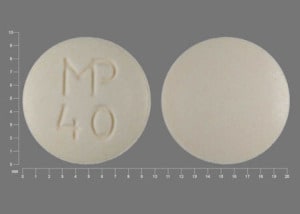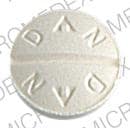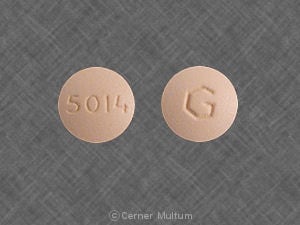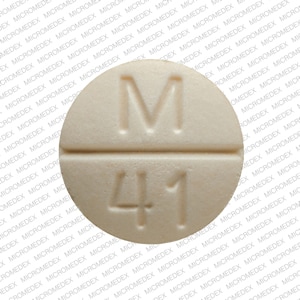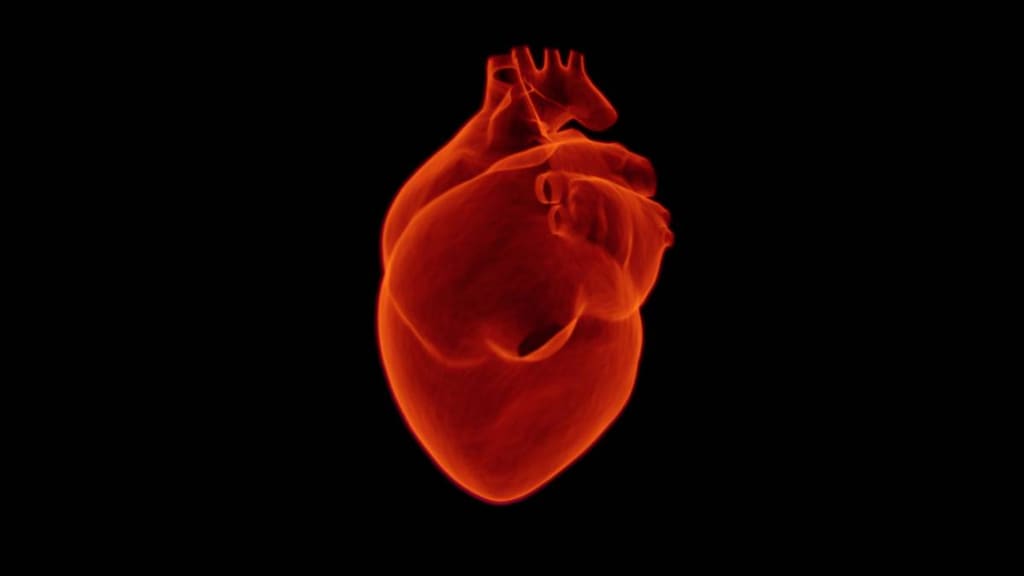Dosage Forms
Excipient information presented when available (limited, particularly for generics); consult specific product labeling.
Tablet, Oral:
Aldactazide:
25/25: Hydrochlorothiazide 25 mg and spironolactone 25 mg
50/50: Hydrochlorothiazide 50 mg and spironolactone 50 mg
Generic: Hydrochlorothiazide 25 mg and spironolactone 25 mg
Use: Labeled Indications
Edema: Treatment of edema in congestive heart failure (CHF), and nephrotic syndrome, and cirrhosis of the liver accompanied by edema and/or ascites.
Hypertension: Management of mild to moderate hypertension.
Contraindications
Hypersensitivity to thiazides or sulfonamide-derived drugs; acute renal insufficiency; anuria; renal decompensation; significant impairment of renal excretory function; hypercalcemia; hyperkalemia; Addison’s disease; acute or severe hepatic impairment
Note: Although the FDA approved product labeling states this medication is contraindicated with other sulfonamide-containing drug classes, the scientific basis of this statement has been challenged. See “Warnings/Precautions” for more detail.
Canadian labeling: Additional contraindications (not in US labeling): Hypersensitivity to spironolactone or any component of the formulation; concomitant use with eplerenone, heparin, or low molecular weight heparin; pregnancy; breast-feeding.
Dosage and Administration
Dosing: Adult
Edema: Oral: Hydrochlorothiazide 25 to 200 mg daily and spironolactone 25 to 200 mg daily in single or divided doses
Hypertension: Oral:
Usual dosage range: Hydrochlorothiazide 50 to 100 mg daily and spironolactone 50 to 100 mg daily
Alternate recommendations: Target dose range of hydrochlorothiazide is 25 to 100 mg in 1 to 2 divided doses (JNC 8 [James 2014]). Usual dosage range: Hydrochlorothiazide 12.5 to 50 mg daily and spironolactone 25 to 50 mg daily (ASH/ISH [Weber 2013])
Dosing: Geriatric
Oral: Consider initiating therapy with the lowest available dose (usual initial doses of hydrochlorothiazide are 12.5 to 25 mg once daily); increase as necessary.
Dosing: Pediatric
Note: Product is a fixed combination of equal mg proportions of components; the following dosage represents mg of each component (hydrochlorothiazide and spironolactone), not the total.
Bronchopulmonary dysplasia (BPD): Limited data available; efficacy results variable. Although the benefits of diuretic therapy in the management of BPD are variable (eg, optimal duration of therapy, impact on pulmonary endpoints), diuretics continue to be used in clinical practice (Slaughter 2013). Infants: Oral: 1.5 mg/kg/dose every 12 hours (Albersheim 1989; Stewart 2011).
Edema (diuresis), Hypertension: Limited data available: Infants, Children, and Adolescents: Oral: Initial: 1 mg/kg/day in divided doses once or twice daily; may titrate up to maximum daily dose: 3 to 3.3 mg/kg/day or 100 mg/day (NHBPEP 2004; NHLBI 2011; Park 2014; van der Vorst 2006)
Extemporaneously Prepared
An oral suspension containing hydrochlorothiazide 5 mg and spironolactone 5 mg per mL may be made with tablets. Crush twenty-four 25 mg hydrochlorothiazide and twenty-four 25 mg spironolactone tablets and reduce to a fine powder. Add small portions of a 1:1 mixture of Ora-Sweet and Ora-Plus and mix to a uniform paste; mix while adding the vehicle in equal proportions to almost 120 mL; transfer to a calibrated bottle, rinse mortar with vehicle, and add sufficient quantity of vehicle to make 120 mL. Label "shake well". Stable 60 days under refrigeration or at room temperature.
Allen LV and Erickson MA, "Stability of Extemporaneously Prepared Pediatric Formulations Using Ora-Plus With Ora-Sweet and Ora-Sweet SF − Part II," Secundum Artem, Volume 6 (1).
Administration
Oral: Administer in single or divided doses with or without food.
Storage
Store below 25°C (77°F).
Hydrochlorothiazide and Spironolactone Images
Drug Interactions
Abiraterone Acetate: Spironolactone may diminish the therapeutic effect of Abiraterone Acetate. Monitor therapy
Ajmaline: Sulfonamides may enhance the adverse/toxic effect of Ajmaline. Specifically, the risk for cholestasis may be increased. Monitor therapy
Alcohol (Ethyl): May enhance the orthostatic hypotensive effect of Thiazide and Thiazide-Like Diuretics. Monitor therapy
Alfuzosin: May enhance the hypotensive effect of Blood Pressure Lowering Agents. Monitor therapy
Allopurinol: Thiazide and Thiazide-Like Diuretics may enhance the potential for allergic or hypersensitivity reactions to Allopurinol. Thiazide and Thiazide-Like Diuretics may increase the serum concentration of Allopurinol. Specifically, Thiazide Diuretics may increase the concentration of Oxypurinol, an active metabolite of Allopurinol. Monitor therapy
Alpha-/Beta-Agonists: Spironolactone may diminish the vasoconstricting effect of Alpha-/Beta-Agonists. Monitor therapy
Amifostine: Blood Pressure Lowering Agents may enhance the hypotensive effect of Amifostine. Management: When amifostine is used at chemotherapy doses, blood pressure lowering medications should be withheld for 24 hours prior to amifostine administration. If blood pressure lowering therapy cannot be withheld, amifostine should not be administered. Consider therapy modification
AMILoride: May enhance the hyperkalemic effect of Spironolactone. Avoid combination
Aminolevulinic Acid (Systemic): Photosensitizing Agents may enhance the photosensitizing effect of Aminolevulinic Acid (Systemic). Avoid combination
Aminolevulinic Acid (Topical): Photosensitizing Agents may enhance the photosensitizing effect of Aminolevulinic Acid (Topical). Monitor therapy
Ammonium Chloride: Potassium-Sparing Diuretics may enhance the adverse/toxic effect of Ammonium Chloride. Specifically the risk of systemic acidosis. Consider therapy modification
Amphetamines: May diminish the antihypertensive effect of Antihypertensive Agents. Monitor therapy
Angiotensin II Receptor Blockers: May enhance the hyperkalemic effect of Potassium-Sparing Diuretics. Monitor therapy
Angiotensin-Converting Enzyme Inhibitors: Potassium-Sparing Diuretics may enhance the hyperkalemic effect of Angiotensin-Converting Enzyme Inhibitors. Monitor therapy
Angiotensin-Converting Enzyme Inhibitors: Thiazide and Thiazide-Like Diuretics may enhance the hypotensive effect of Angiotensin-Converting Enzyme Inhibitors. Thiazide and Thiazide-Like Diuretics may enhance the nephrotoxic effect of Angiotensin-Converting Enzyme Inhibitors. Monitor therapy
Anticholinergic Agents: May increase the serum concentration of Thiazide and Thiazide-Like Diuretics. Monitor therapy
Antidiabetic Agents: Thiazide and Thiazide-Like Diuretics may diminish the therapeutic effect of Antidiabetic Agents. Monitor therapy
Antidiabetic Agents: Hyperglycemia-Associated Agents may diminish the therapeutic effect of Antidiabetic Agents. Monitor therapy
Antipsychotic Agents (Second Generation [Atypical]): Blood Pressure Lowering Agents may enhance the hypotensive effect of Antipsychotic Agents (Second Generation [Atypical]). Monitor therapy
Aspirin: May diminish the therapeutic effect of Spironolactone. Monitor therapy
AtorvaSTATin: May enhance the adverse/toxic effect of Spironolactone. Specifically, there is a theoretical potential for enhanced effects on reducing endogenous steroid activity. Monitor therapy
Barbiturates: May enhance the hypotensive effect of Blood Pressure Lowering Agents. Monitor therapy
Benazepril: HydroCHLOROthiazide may enhance the hypotensive effect of Benazepril. HydroCHLOROthiazide may enhance the nephrotoxic effect of Benazepril. Benazepril may decrease the serum concentration of HydroCHLOROthiazide. Monitor therapy
Benperidol: May enhance the hypotensive effect of Blood Pressure Lowering Agents. Monitor therapy
Beta2-Agonists: May enhance the hypokalemic effect of Thiazide and Thiazide-Like Diuretics. Monitor therapy
Bile Acid Sequestrants: May decrease the absorption of Thiazide and Thiazide-Like Diuretics. The diuretic response is likewise decreased. Consider therapy modification
Brigatinib: May diminish the antihypertensive effect of Antihypertensive Agents. Brigatinib may enhance the bradycardic effect of Antihypertensive Agents. Monitor therapy
Brimonidine (Topical): May enhance the hypotensive effect of Blood Pressure Lowering Agents. Monitor therapy
Bromperidol: Blood Pressure Lowering Agents may enhance the hypotensive effect of Bromperidol. Bromperidol may diminish the hypotensive effect of Blood Pressure Lowering Agents. Avoid combination
Calcium Salts: Thiazide and Thiazide-Like Diuretics may decrease the excretion of Calcium Salts. Continued concomitant use can also result in metabolic alkalosis. Monitor therapy
CarBAMazepine: Thiazide and Thiazide-Like Diuretics may enhance the adverse/toxic effect of CarBAMazepine. Specifically, there may be an increased risk for hyponatremia. Monitor therapy
Cardiac Glycosides: Potassium-Sparing Diuretics may diminish the therapeutic effect of Cardiac Glycosides. In particular, the inotropic effects of digoxin appear to be diminished. Potassium-Sparing Diuretics may increase the serum concentration of Cardiac Glycosides. This particular effect may be unique to Spironolactone. Monitor therapy
Cardiac Glycosides: Thiazide and Thiazide-Like Diuretics may enhance the adverse/toxic effect of Cardiac Glycosides. Specifically, cardiac glycoside toxicity may be enhanced by the hypokalemic and hypomagnesemic effect of thiazide diuretics. Monitor therapy
Ciprofloxacin (Systemic): Spironolactone may enhance the arrhythmogenic effect of Ciprofloxacin (Systemic). Monitor therapy
Corticosteroids (Orally Inhaled): May enhance the hypokalemic effect of Thiazide and Thiazide-Like Diuretics. Monitor therapy
Corticosteroids (Systemic): May enhance the hypokalemic effect of Thiazide and Thiazide-Like Diuretics. Monitor therapy
Cosyntropin: Spironolactone may diminish the diagnostic effect of Cosyntropin. Management: Patients receiving spironolactone should omit their pre-test dose on the day selected for cosyntropin testing. Consider therapy modification
Cyclophosphamide: Thiazide and Thiazide-Like Diuretics may enhance the adverse/toxic effect of Cyclophosphamide. Specifically, granulocytopenia may be enhanced. Monitor therapy
CycloSPORINE (Systemic): Potassium-Sparing Diuretics may enhance the hyperkalemic effect of CycloSPORINE (Systemic). Avoid combination
Dexketoprofen: May enhance the adverse/toxic effect of Sulfonamides. Monitor therapy
Dexmethylphenidate: May diminish the therapeutic effect of Antihypertensive Agents. Monitor therapy
Diacerein: May enhance the therapeutic effect of Diuretics. Specifically, the risk for dehydration or hypokalemia may be increased. Monitor therapy
Diazoxide: Thiazide and Thiazide-Like Diuretics may enhance the adverse/toxic effect of Diazoxide. Monitor therapy
Diazoxide: May enhance the hypotensive effect of Blood Pressure Lowering Agents. Monitor therapy
Dichlorphenamide: Thiazide and Thiazide-Like Diuretics may enhance the hypokalemic effect of Dichlorphenamide. Monitor therapy
Digoxin: Spironolactone may increase the serum concentration of Digoxin. Spironolactone (and/or its metabolites) may also interfere with the assays used to determine Digoxin concentrations, falsely increasing or decreasing Digoxin concentrations. Monitor therapy
Dofetilide: HydroCHLOROthiazide may enhance the QTc-prolonging effect of Dofetilide. HydroCHLOROthiazide may increase the serum concentration of Dofetilide. Avoid combination
Drospirenone: May enhance the hyperkalemic effect of Potassium-Sparing Diuretics. Monitor therapy
DULoxetine: Blood Pressure Lowering Agents may enhance the hypotensive effect of DULoxetine. Monitor therapy
Eplerenone: May enhance the hyperkalemic effect of Potassium-Sparing Diuretics. Management: This combination is contraindicated in patients receiving eplerenone for treatment of hypertension. Consider therapy modification
Fexinidazole [INT]: Thiazide and Thiazide-Like Diuretics may enhance the arrhythmogenic effect of Fexinidazole [INT]. Avoid combination
Heparin: May enhance the hyperkalemic effect of Potassium-Sparing Diuretics. Management: Monitor serum potassium concentrations closely. The spironolactone Canadian product monograph lists its combination with heparin or low molecular weight heparins as contraindicated. Monitor therapy
Heparins (Low Molecular Weight): May enhance the hyperkalemic effect of Potassium-Sparing Diuretics. Management: Monitor serum potassium concentrations closely. The spironolactone Canadian product monograph lists its combination with heparin or low molecular weight heparins as contraindicated. Monitor therapy
Herbs (Hypertensive Properties): May diminish the antihypertensive effect of Antihypertensive Agents. Monitor therapy
Herbs (Hypotensive Properties): May enhance the hypotensive effect of Blood Pressure Lowering Agents. Monitor therapy
Hypotension-Associated Agents: Blood Pressure Lowering Agents may enhance the hypotensive effect of Hypotension-Associated Agents. Monitor therapy
Ipragliflozin: May enhance the adverse/toxic effect of Thiazide and Thiazide-Like Diuretics. Specifically, the risk for intravascular volume depletion may be increased. Monitor therapy
Ivabradine: Thiazide and Thiazide-Like Diuretics may enhance the arrhythmogenic effect of Ivabradine. Monitor therapy
Levodopa-Containing Products: Blood Pressure Lowering Agents may enhance the hypotensive effect of Levodopa-Containing Products. Monitor therapy
Levosulpiride: Thiazide and Thiazide-Like Diuretics may enhance the adverse/toxic effect of Levosulpiride. Avoid combination
Licorice: May enhance the hypokalemic effect of Thiazide and Thiazide-Like Diuretics. Monitor therapy
Lithium: Thiazide and Thiazide-Like Diuretics may decrease the excretion of Lithium. Consider therapy modification
Lormetazepam: May enhance the hypotensive effect of Blood Pressure Lowering Agents. Monitor therapy
Mecamylamine: Sulfonamides may enhance the adverse/toxic effect of Mecamylamine. Avoid combination
Methenamine: Thiazide and Thiazide-Like Diuretics may diminish the therapeutic effect of Methenamine. Monitor therapy
Methylphenidate: May diminish the antihypertensive effect of Antihypertensive Agents. Monitor therapy
Mitotane: Spironolactone may diminish the therapeutic effect of Mitotane. Management: Consideration should be given to discontinuing spironolactone prior to initiating mitotane in order to eliminate the risk of therapeutic failure of the mitotane. Consider therapy modification
Molsidomine: May enhance the hypotensive effect of Blood Pressure Lowering Agents. Monitor therapy
Multivitamins/Fluoride (with ADE): May enhance the hypercalcemic effect of Thiazide and Thiazide-Like Diuretics. Monitor therapy
Multivitamins/Minerals (with ADEK, Folate, Iron): Thiazide and Thiazide-Like Diuretics may enhance the hypercalcemic effect of Multivitamins/Minerals (with ADEK, Folate, Iron). Monitor therapy
Multivitamins/Minerals (with AE, No Iron): Thiazide and Thiazide-Like Diuretics may increase the serum concentration of Multivitamins/Minerals (with AE, No Iron). Specifically, thiazide diuretics may decrease the excretion of calcium, and continued concomitant use can also result in metabolic alkalosis. Monitor therapy
Naftopidil: May enhance the hypotensive effect of Blood Pressure Lowering Agents. Monitor therapy
Neuromuscular-Blocking Agents (Nondepolarizing): Spironolactone may enhance the neuromuscular-blocking effect of Neuromuscular-Blocking Agents (Nondepolarizing). Monitor therapy
Nicergoline: May enhance the hypotensive effect of Blood Pressure Lowering Agents. Monitor therapy
Nicorandil: May enhance the hyperkalemic effect of Potassium-Sparing Diuretics. Monitor therapy
Nicorandil: May enhance the hypotensive effect of Blood Pressure Lowering Agents. Monitor therapy
Nitroprusside: Blood Pressure Lowering Agents may enhance the hypotensive effect of Nitroprusside. Monitor therapy
Nonsteroidal Anti-Inflammatory Agents: Thiazide and Thiazide-Like Diuretics may enhance the nephrotoxic effect of Nonsteroidal Anti-Inflammatory Agents. Nonsteroidal Anti-Inflammatory Agents may diminish the therapeutic effect of Thiazide and Thiazide-Like Diuretics. Monitor therapy
Nonsteroidal Anti-Inflammatory Agents: May diminish the antihypertensive effect of Potassium-Sparing Diuretics. Nonsteroidal Anti-Inflammatory Agents may enhance the hyperkalemic effect of Potassium-Sparing Diuretics. Monitor therapy
Obinutuzumab: May enhance the hypotensive effect of Blood Pressure Lowering Agents. Management: Consider temporarily withholding blood pressure lowering medications beginning 12 hours prior to obinutuzumab infusion and continuing until 1 hour after the end of the infusion. Consider therapy modification
Opioid Agonists: May enhance the adverse/toxic effect of Diuretics. Opioid Agonists may diminish the therapeutic effect of Diuretics. Monitor therapy
OXcarbazepine: Thiazide and Thiazide-Like Diuretics may enhance the adverse/toxic effect of OXcarbazepine. Specifically, there may be an increased risk for hyponatremia. Monitor therapy
Pentoxifylline: May enhance the hypotensive effect of Blood Pressure Lowering Agents. Monitor therapy
Pholcodine: Blood Pressure Lowering Agents may enhance the hypotensive effect of Pholcodine. Monitor therapy
Phosphodiesterase 5 Inhibitors: May enhance the hypotensive effect of Blood Pressure Lowering Agents. Monitor therapy
Porfimer: Photosensitizing Agents may enhance the photosensitizing effect of Porfimer. Monitor therapy
Potassium Salts: May enhance the hyperkalemic effect of Potassium-Sparing Diuretics. Consider therapy modification
Promazine: Thiazide and Thiazide-Like Diuretics may enhance the QTc-prolonging effect of Promazine. Avoid combination
Prostacyclin Analogues: May enhance the hypotensive effect of Blood Pressure Lowering Agents. Monitor therapy
Quinagolide: May enhance the hypotensive effect of Blood Pressure Lowering Agents. Monitor therapy
QuiNIDine: Potassium-Sparing Diuretics may diminish the therapeutic effect of QuiNIDine. Monitor therapy
Reboxetine: May enhance the hypokalemic effect of Thiazide and Thiazide-Like Diuretics. Monitor therapy
Selective Serotonin Reuptake Inhibitors: May enhance the hyponatremic effect of Thiazide and Thiazide-Like Diuretics. Monitor therapy
Sodium Phosphates: Diuretics may enhance the nephrotoxic effect of Sodium Phosphates. Specifically, the risk of acute phosphate nephropathy may be enhanced. Management: Consider avoiding this combination by temporarily suspending treatment with diuretics, or seeking alternatives to oral sodium phosphate bowel preparation. If the combination cannot be avoided, hydrate adequately and monitor fluid and renal status. Consider therapy modification
Tacrolimus (Systemic): Potassium-Sparing Diuretics may enhance the hyperkalemic effect of Tacrolimus (Systemic). Monitor therapy
Tolvaptan: May enhance the hyperkalemic effect of Potassium-Sparing Diuretics. Monitor therapy
Topiramate: Thiazide and Thiazide-Like Diuretics may enhance the hypokalemic effect of Topiramate. Thiazide and Thiazide-Like Diuretics may increase the serum concentration of Topiramate. Management: Monitor for increased topiramate levels/adverse effects (e.g., hypokalemia) with initiation/dose increase of a thiazide diuretic. Closely monitor serum potassium concentrations with concomitant therapy. Topiramate dose reductions may be necessary. Consider therapy modification
Toremifene: Thiazide and Thiazide-Like Diuretics may enhance the hypercalcemic effect of Toremifene. Monitor therapy
Triamterene: May enhance the hyperkalemic effect of Spironolactone. Avoid combination
Trimethoprim: May enhance the hyperkalemic effect of Spironolactone. Monitor therapy
Valsartan: HydroCHLOROthiazide may enhance the hypotensive effect of Valsartan. Valsartan may increase the serum concentration of HydroCHLOROthiazide. Monitor therapy
Verteporfin: Photosensitizing Agents may enhance the photosensitizing effect of Verteporfin. Monitor therapy
Vitamin D Analogs: Thiazide and Thiazide-Like Diuretics may enhance the hypercalcemic effect of Vitamin D Analogs. Monitor therapy
Yohimbine: May diminish the antihypertensive effect of Antihypertensive Agents. Monitor therapy
Test Interactions
See individual agents.
Adverse Reactions
See individual agents.
Warnings/Precautions
Concerns related to adverse effects:
- CNS effects: Somnolence and dizziness have been reported with use; advise patients to use caution when driving or operating machinery until response to initial treatment has been determined.
- Electrolyte disturbances: Hyperkalemia may occur with spironolactone; risk factors include renal dysfunction, diabetes mellitus, and concomitant use of potassium-sparing diuretics, potassium supplements, and/or potassium-containing salts. Use cautiously, if at all, with these agents and monitor potassium closely. Thiazide diuretics may cause hypokalemia, hypochloremic alkalosis, hypomagnesemia, and hyponatremia.
- Gout: In certain patients with a history of gout, a familial predisposition to gout, or chronic renal failure, gout can be precipitated by hydrochlorothiazide. This risk may be increased with doses ≥25 mg (Gurwitz 1997).
- Gynecomastia: Related to dose and duration of spironolactone therapy; typically is reversible following discontinuation of therapy but may persist (rare).
- Hyperkalemia: Monitor closely for hyperkalemia; increases in serum potassium are dose related and rates of hyperkalemia also increase with declining renal function. The concurrent use of larger doses of ACE inhibitors (eg, ≥ lisinopril 10 mg daily in adults) also increases the risk of hyperkalemia (ACCF/AHA [Yancy 2013]). Dose reduction or interruption of therapy may be necessary with development of hyperkalemia. Use is contraindicated in patients with hyperkalemia; use caution in conditions known to cause hyperkalemia.
- Hypersensitivity reactions: Hypersensitivity reactions may occur with hydrochlorothiazide. Risk is increased in patients with a history of allergy or bronchial asthma.
- Ocular effects: Hydrochlorothiazide may cause acute transient myopia and acute angle-closure glaucoma, typically occurring within hours to weeks following initiation; discontinue therapy immediately in patients with acute decreases in visual acuity or ocular pain. Additional treatments may be needed if uncontrolled intraocular pressure persists. Risk factors may include a history of sulfonamide or penicillin allergy.
- Photosensitivity: Photosensitization may occur.
- Sulfonamide (“sulfa”) allergy: The FDA-approved product labeling for many medications containing a sulfonamide chemical group includes a broad contraindication in patients with a prior allergic reaction to sulfonamides. There is a potential for cross-reactivity between members of a specific class (eg, two antibiotic sulfonamides). However, concerns for cross-reactivity have previously extended to all compounds containing the sulfonamide structure (SO2NH2). An expanded understanding of allergic mechanisms indicates cross-reactivity between antibiotic sulfonamides and nonantibiotic sulfonamides may not occur or at the very least this potential is extremely low (Brackett 2004; Johnson 2005; Slatore 2004; Tornero 2004). In particular, mechanisms of cross-reaction due to antibody production (anaphylaxis) are unlikely to occur with nonantibiotic sulfonamides. T-cell-mediated (type IV) reactions (eg, maculopapular rash) are less well understood and it is not possible to completely exclude this potential based on current insights. In cases where prior reactions were severe (Stevens-Johnson syndrome/TEN), some clinicians choose to avoid exposure to these classes.
- Tumorigenic: Spironolactone shown to be a tumorigen in chronic toxicity animal studies. Avoid unnecessary use.
Disease-related concerns:
- Bariatric surgery: Dehydration: Avoid diuretics in the immediate postoperative period after bariatric surgery; electrolyte disturbances and dehydration may occur. Diuretics may be resumed, if indicated, once oral fluid intake goals are met (Ziegler 2009).
- Diabetes: Use hydrochlorothiazide with caution in patients with prediabetes or diabetes mellitus; may see a change in glucose control.
- Hepatic impairment: Use caution in patients with mild or moderate hepatic impairment; use is contraindicated in acute or severe hepatic impairment. In progressive or severe liver disease, electrolyte and acid/base imbalances might lead to hepatic encephalopathy/coma.
- Hypercalcemia: Thiazide diuretics may decrease renal calcium excretion; use is contraindicated in patients with hypercalcemia.
- Hypercholesterolemia: Use with caution in patients with moderate or high cholesterol concentrations; increased cholesterol and triglyceride levels have been reported with thiazides.
- Parathyroid disease: Thiazide diuretics reduce calcium excretion; pathologic changes in the parathyroid glands with hypercalcemia and hypophosphatemia have been observed with prolonged use; should be discontinued prior to testing for parathyroid function.
- Renal impairment: Cumulative effects of hydrochlorothiazide may develop, including azotemia, in patients with impaired renal function. Avoid hydrochlorothiazide in severe renal disease (ineffective). Spironolactone may cause hyperkalemia in patients with renal impairment; risk of hyperkalemia is increased with declining renal function and with the concurrent use of larger doses of ACE inhibitors (eg, ≥ lisinopril 10 mg daily in adults) (ACCF/AHA [Yancy 2013]). Use with caution in patients with mild renal impairment; contraindicated with anuria, acute renal insufficiency, renal decompensation, or significant impairment of renal excretory function.
- Systemic lupus erythematosus (SLE): Hydrochlorothiazide can cause SLE exacerbation or activation.
Concurrent drug therapy issues:
- Drug-drug interactions: Potentially significant interactions may exist, requiring dose or frequency adjustment, additional monitoring, and/or selection of alternative therapy. Consult drug interactions database for more detailed information.
Special populations:
- Elderly: Avoid use of spironolactone doses >25 mg/day in elderly patients with heart failure or with reduced renal function (eg, CrCl <30 mL/minute or eGFR ≤30 mL/minute/1.73 m2 [Yancy 2013]).
Monitoring Parameters
Blood pressure; serum electrolytes, I & O ratios, renal function
Pregnancy
Pregnancy Considerations
Animal reproduction studies have not been conducted with this combination product. See individual agents.
Patient Education
- Discuss specific use of drug and side effects with patient as it relates to treatment. (HCAHPS: During this hospital stay, were you given any medicine that you had not taken before? Before giving you any new medicine, how often did hospital staff tell you what the medicine was for? How often did hospital staff describe possible side effects in a way you could understand?)
- Patient may experience constipation, diarrhea, dizziness, fatigue, headache, lack of appetite, restlessness, loss of strength and energy, vomiting, or nausea. Have patient report immediately to prescriber signs of high blood sugar (confusion, fatigue, increased thirst, increased hunger, passing a lot of urine, flushing, fast breathing, or breath that smells like fruit), signs of fluid and electrolyte problems (mood changes, confusion, muscle pain or weakness, abnormal heartbeat, severe dizziness, passing out, fast heartbeat, increased thirst, seizures, loss of strength and energy, lack of appetite, unable to pass urine or change in amount of urine passed, dry mouth, dry eyes, nausea, or vomiting), signs of liver problems (dark urine, fatigue, lack of appetite, nausea, abdominal pain, light-colored stools, vomiting, or yellow skin), signs of pancreatitis (severe abdominal pain, severe back pain, severe nausea, or vomiting), signs of kidney problems (unable to pass urine, blood in the urine, change in amount of urine passed, or weight gain), signs of lupus (rash on the cheeks or other body parts, sunburn easy, muscle or joint pain, chest pain or shortness of breath, or swelling in the arms or legs), signs of bleeding (vomiting blood or vomit that looks like coffee grounds; coughing up blood; blood in the urine; black, red, or tarry stools; bleeding from the gums; abnormal vaginal bleeding; bruises without a reason or that get bigger; or any severe or persistent bleeding), severe abdominal pain, change in balance, sexual dysfunction, chills, sore throat, burning or numbness feeling, shortness of breath, enlarged breasts (males), menstrual changes, skin changes, vision changes, or eye pain (HCAHPS).
- Educate patient about signs of a significant reaction (eg, wheezing; chest tightness; fever; itching; bad cough; blue skin color; seizures; or swelling of face, lips, tongue, or throat). Note: This is not a comprehensive list of all side effects. Patient should consult prescriber for additional questions.
Intended Use and Disclaimer: Should not be printed and given to patients. This information is intended to serve as a concise initial reference for health care professionals to use when discussing medications with a patient. You must ultimately rely on your own discretion, experience, and judgment in diagnosing, treating, and advising patients.
